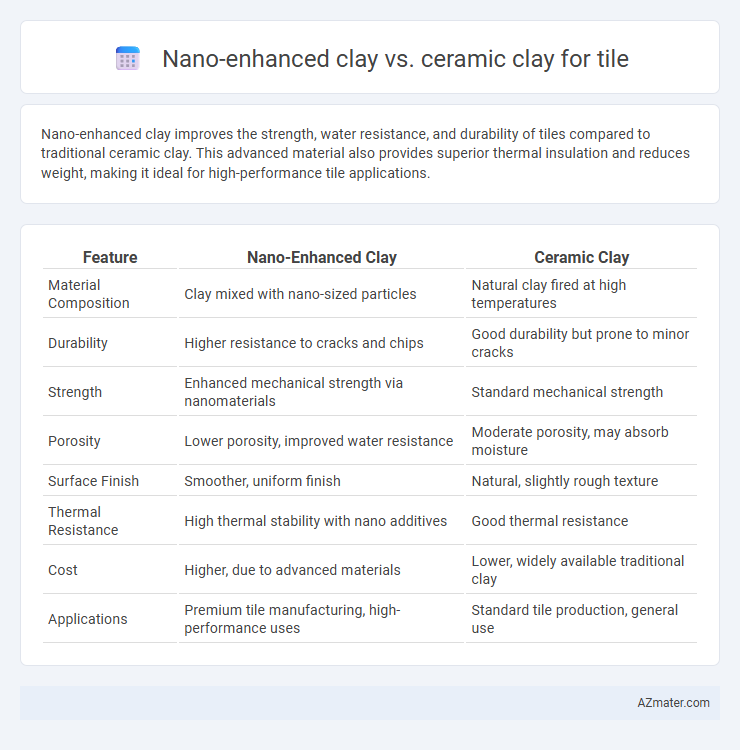Nano-enhanced clay improves the strength, water resistance, and durability of tiles compared to traditional ceramic clay. This advanced material also provides superior thermal insulation and reduces weight, making it ideal for high-performance tile applications.
Table of Comparison
| Feature | Nano-Enhanced Clay | Ceramic Clay |
|---|---|---|
| Material Composition | Clay mixed with nano-sized particles | Natural clay fired at high temperatures |
| Durability | Higher resistance to cracks and chips | Good durability but prone to minor cracks |
| Strength | Enhanced mechanical strength via nanomaterials | Standard mechanical strength |
| Porosity | Lower porosity, improved water resistance | Moderate porosity, may absorb moisture |
| Surface Finish | Smoother, uniform finish | Natural, slightly rough texture |
| Thermal Resistance | High thermal stability with nano additives | Good thermal resistance |
| Cost | Higher, due to advanced materials | Lower, widely available traditional clay |
| Applications | Premium tile manufacturing, high-performance uses | Standard tile production, general use |
Introduction to Tile Materials: Nano-Enhanced vs Ceramic Clay
Nano-enhanced clay incorporates nanoparticles to improve the mechanical strength, water absorption rate, and durability of tiles compared to traditional ceramic clay. Ceramic clay remains a widely used material due to its natural composition, ease of molding, and cost-effectiveness in tile manufacturing. Advancements in nano-technology enable nano-enhanced clay tiles to exhibit superior resistance to wear and environmental factors, making them ideal for high-performance applications.
What is Nano-Enhanced Clay? Key Features and Composition
Nano-enhanced clay incorporates nanoparticles into traditional clay to improve its mechanical strength, thermal stability, and surface durability, making it an advanced material for tile production. The key features include enhanced scratch resistance, reduced water absorption, and improved adhesion properties due to the homogeneous dispersion of nano-sized particles within the clay matrix. Its composition typically blends natural clay minerals with engineered nanoparticles such as nano-silica or nano-alumina, optimizing tile performance and longevity.
Ceramic Clay Explained: Traditional Properties and Uses
Ceramic clay is composed primarily of kaolinite, ball clay, and feldspar, offering excellent plasticity, durability, and heat resistance essential for tile production. It has been historically favored for its ability to withstand high firing temperatures, resulting in strong, waterproof tiles commonly used in flooring and wall applications. In contrast, nano-enhanced clay incorporates nanoscale additives to improve mechanical strength and reduce porosity, but traditional ceramic clay remains preferred for its consistent performance and well-established firing processes.
Manufacturing Processes: Nano-Enhanced Clay vs Ceramic Clay
Nano-enhanced clay incorporates nanoparticles into the clay matrix, improving particle dispersion and enhancing sintering efficiency during tile manufacturing. Traditional ceramic clay relies on conventional raw materials and firing techniques that result in slower densification and potentially higher porosity. The integration of nanomaterials accelerates the vitrification process, enabling tiles with superior mechanical strength and reduced microcracks compared to those made from standard ceramic clay.
Durability and Strength Comparison
Nano-enhanced clay tiles exhibit superior durability and strength due to the incorporation of nanoparticles that reinforce the clay matrix, resulting in higher resistance to cracking, impact, and wear. Ceramic clay tiles, while traditionally robust and widely used, generally show lower tensile strength and are more prone to chipping under heavy mechanical stress. Studies indicate that nano-enhanced clay formulations can improve flexural strength by up to 30%, making them an ideal choice for high-traffic and demanding architectural applications.
Water Resistance: Which Clay Offers Better Performance?
Nano-enhanced clay exhibits superior water resistance compared to ceramic clay due to its densely packed nanoparticles that fill micro-pores, effectively reducing water absorption rates below 2%. Ceramic clay tiles typically have higher porosity, with water absorption values ranging from 3% to 6%, making them more susceptible to moisture damage over time. The enhanced hydrophobic properties of nano-clay contribute to improved durability and longevity in wet environments, making it the preferred choice for water-resistant tile applications.
Aesthetic Versatility and Design Possibilities
Nano-enhanced clay offers superior aesthetic versatility and design possibilities for tiles due to its refined particle size, enabling intricate textures and vibrant color integration. Compared to traditional ceramic clay, nano-enhanced clay allows for smoother finishes and more precise detailing, enhancing visual appeal and customization options. This advanced material supports innovative glazing techniques and complex patterns, expanding creative potential in tile design.
Cost Analysis: Nano-Enhanced vs Ceramic Clay Tiles
Nano-enhanced clay tiles generally exhibit higher initial costs due to advanced material processing and incorporation of nanoparticles, which improve durability and resistance to wear. Ceramic clay tiles offer a more budget-friendly option with widespread availability and lower manufacturing expenses but may require more frequent replacement over time. When considering long-term cost efficiency, nano-enhanced tiles can provide better value through enhanced lifespan and reduced maintenance expenses compared to traditional ceramic clay tiles.
Environmental Impact and Sustainability
Nano-enhanced clay tiles offer improved durability and reduced water absorption, leading to a longer lifespan and decreased frequency of replacement compared to traditional ceramic clay tiles. The manufacturing process of nano-enhanced clay can be more energy-efficient due to lower firing temperatures and reduced raw material consumption, contributing to a smaller carbon footprint. Ceramic clay tiles, while widely used, generally require higher energy inputs for production and exhibit higher porosity, which may result in increased maintenance and environmental impact over time.
Choosing the Right Tile Material: Practical Considerations
Nano-enhanced clay tiles offer superior durability, improved water resistance, and enhanced surface hardness compared to traditional ceramic clay tiles, making them ideal for high-traffic and moisture-prone areas. Ceramic clay tiles provide excellent thermal insulation and are typically more cost-effective, suitable for indoor applications with moderate wear. When choosing the right tile material, consider the installation environment, expected wear, and maintenance requirements to optimize longevity and performance.

Infographic: Nano-enhanced clay vs Ceramic clay for Tile
 azmater.com
azmater.com